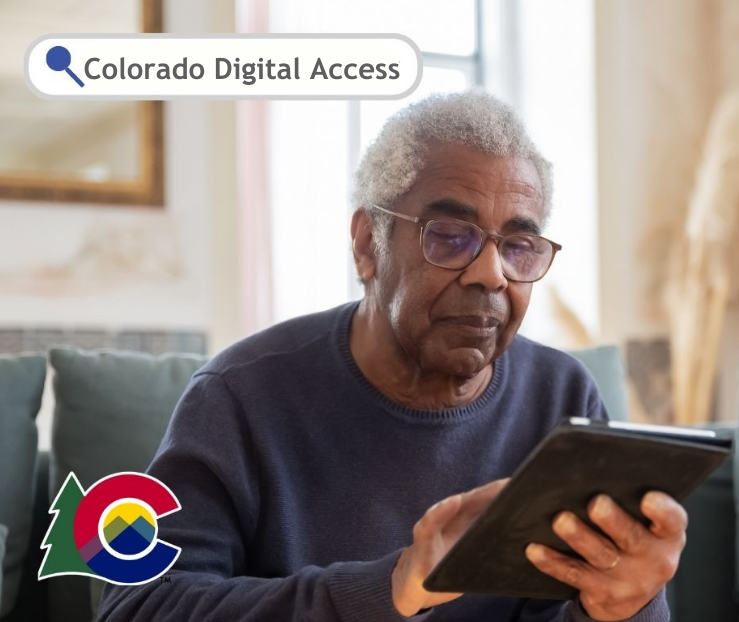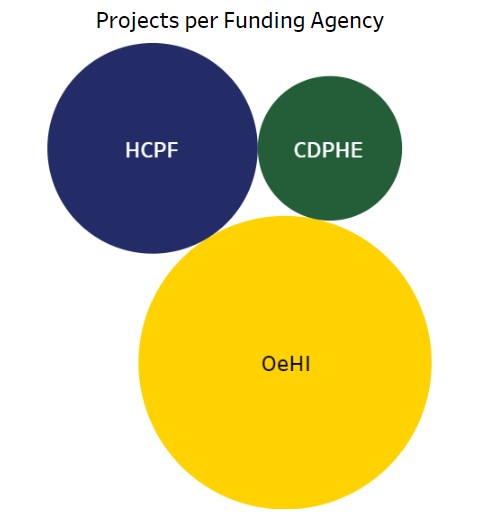Telehealth
What Is Telehealth?
Telehealth is a broad term that encompasses a variety of telecommunications technologies and tactics to provide health services from a distance. It is not a specific clinical service, but rather a collection of means to enhance care and education delivery.
OeHI’s Telehealth Initiative develops and supports approaches that lead to increased adoption of telehealth through a framework of digital access. Telehealth is an important avenue to support health care reform, and has the potential to be a tool for addressing long-standing access issues. OeHI is working with partners across agencies, sectors, and throughout the state to support equal access to telehealth and to advance programs that work towards all individuals and communities having the information technology capacity needed for full participation in society.
In order for telehealth to truly benefit those most burdened by challenges in accessing healthcare, broadband access needs to be ubiquitous, and access to educational opportunities for digital skill development and web-enabled devices must be equally accessible. Otherwise, telehealth runs the risk of only benefiting those who have the broadband access, skills, and devices required for a telehealth visit.
Colorado Digital Access Plan
As the Colorado Broadband Office coordinates broadband efforts to create more access to high-speed internet, they have partnered with the Office of the Future of Work (OFW) and the Office of eHealth Innovation (OeHI) to lead activities related to digital literacy and inclusion. OFW and OeHI led the creation of the Colorado Digital Access Plan. For more information on this and digital literacy and inclusion efforts, visit the OFW’s Digital Equity, Literacy, and Inclusion Initiative webpage or reach out to gov_ask_oehi@state.co.us.

Telehealth Projects at OeHI
Northwest/Western Colorado Telehealth Study
In partnership with Connected Nation, OeHI conducted a survey of 800 adults in rural Colorado households in the northwest portion of the state. The purpose of the survey was to examine how Coloradans are using telehealth services and barriers that prevent some from using telehealth. The results of the survey uncovered challenges faced by rural Coloradans as they try to connect to telehealth services, as well what messaging would be most effective to increase telehealth adoption among non-users.
Telehealth Payment and Denials Parity Project
Providers have reported challenges and claims denials when attempting to bill for telehealth, particularly with commercial payers. Respondents to the Colorado Provider Telehealth surveys (more information below) indicated that low or no reimbursement is challenging, with 19% of respondents indicating that it will not be easy to continue using telehealth in a way that is financially viable for their practice. However, payment parity for telehealth services has been in place in Colorado since 2017, and in 2020 Colorado expanded parity further.
OeHI partnered with Center for Improving Value in Health Care (CIVHC) and the Department of Insurance to analyze both Colorado All Payer Claims Database (APCD) data and denials data collected by the Division of Insurance from five commercial payers. The goal of this project was to see if existing legislation has resulted in payment parity between in-person and telehealth services in Colorado, and if there is parity in the rate of claims denials for telehealth compared to in-person services.
See key findings for this analysis in the Telehealth vs In-Person Payment Comparison Infographic and Executive Summary.
The full reports can be found below:
2023 Telehealth Report
OeHI partnered with the Peer Mentored Care Collaborative within the Colorado Anschutz Medical Campus on an evaluation tying outcomes and notable differences based on payer source and population between virtual care and in-person visits. This includes Colorado program evaluations and their impact in the state, and initial recommendations on increasing equitable access to telehealth.
Colorado Telehealth Provider Survey Reports
OeHI and Prime Health conducted a survey to healthcare providers and staff in 2021 to better understand how the state can support expanded telehealth services in Colorado. This group conducted a follow-up report in 2022 to see how these needs evolved after the height of the COVID-19 pandemic. The reports provide context for telehealth decision-making and policy in Colorado, and how we can support Colorado providers.
The reports can be found below:
- 2021 Colorado Telehealth Provider Survey Report (PDF)
- Key findings include:
- 71% of respondents are motivated to increase the use of telehealth in their practice;
- Top barriers to expanding telehealth include patient technology challenges and telehealth workflows;
- Respondents identified lack of access to broadband and internet, digital literacy, and a preference for in-person visits as the most significant barriers for patients in accessing telehealth.
- 2022 Colorado Telehealth Provider Survey (PDF)
- Key findings include:
- Patient access to telehealth services remains an issue, with broadband/internet access and digital literacy the top two barriers to patient access identified by telehealth providers;
- Training remains the top resource need identified by all providers (those currently utilizing telehealth and those who are not)
- Sentiments and utilization of telehealth remain positive.
Non-Governmental Funding for Health IT in Colorado
OeHI worked with students from UC Denver to conduct a landscape analysis of private and nonprofit funding opportunities to support health IT, specifically telehealth, electronic health records, and cybersecurity in order to understand gaps in funding and potential partnership opportunities.
Effects of Remote Patient Monitoring
OeHI and the Department of Health Care Policy & Financing's (HCPF) Health Programs Office partnered with the Colorado Health Institute (CHI) to examine the effect of remote patient monitoring (RPM) on health outcomes, potential cost savings from RPM, and operational considerations for providers considering implementing RPM. CHI reviewed information from peer-reviewed literature, white papers, and industry publications, and spoke with a telemedicine expert and the Colorado Rural Health Center (CRHC) to inform this memo.
The published findings can be found below:
Connect to Health @Your Library Project
In a collaborative effort between the Office of eHealth Innovation (OeHI) and the Colorado State Library, 26 rural libraries (representing 41 different branches) were funded in 2024 and 2025 to purchase equipment that patrons can use for telehealth and other virtual services. These libraries span the entire state, from Dolores to Julesburg, in an effort to leverage existing infrastructure to increase telehealth access for rural communities. For more information on the project:
- Visit the Connect to Health @Your Library website
- To learn how the project is impacting rural communities, check out the two-page Utilization Snapshot
- Connect to Health @Your Library one-pager
Telehealth + Broadband RFA
HB21-1289 directed the Colorado Broadband Office to award grants to providers of telehealth services. In partnership with OeHI, over $6 million was granted to 11 organizations serving 36 of Colorado’s counties. The grantees include behavioral health providers, hospitals, emergency care responders, and the Department of Corrections.
The funds are going to support organizations in bolstering their internet connectivity, lending devices to patients so they can access care virtually, supporting the implementation of remote patient monitoring and eConsults, and purchasing equipment to further support provider capacity to see patients virtually.
This funding opportunity is no longer accepting applications.
Reproductive and Sexual Health Chatbot
OeHI partnered with Clinic Chat to develop and launch a chatbot to help people seeking reproductive health services learn what services are available in Colorado, what people seeking care can expect, how to maintain privacy around accessing services, and how to access care.
The artificially intelligent (AI) chatbot uses natural language processing (NLP) and machine learning (ML) via a web-enabled and/or phone-based text message enabled technology platform.
The chatbot is live on a number of Colorado based organizations websites, such as the Colorado Black Health Collaborative, Boulder Valley Health Center, and COLOR Latina. Check out this flyer if your organization would like to partner with Clinic Chat on curating the chatbot to fit the needs of your community.
The Telehealth Equity Dashboard
OeHI partnered with CIVHC to better understand inequities in telehealth access in Colorado. This dashboard shows census tract level analysis of telehealth and in-person utilization to understand indicators of access barriers beyond broadband, and will include tying a variety of known access barriers with different demographic groups using American Community Survey data.
The aim of this analysis is to dig into inequities in telehealth access, and in turn guide interventions and programming to create more equitable access. To see key insights and findings from the dashboard, check out the Telehealth Equity Infographic.
View the Telehealth Equity Analysis dashboard on CIVHC’s website
Three Publications on the Value of Telemedicine During the COVID-19 Response
OeHI partnered with the Colorado Health Institute (CHI) to examine the value proposition of telehealth services in light of the COVID-19 pandemic and Colorado’s rapid transition to virtual care delivery. CHI developed an analysis plan that utilized key informant interviews and electronic health record data from the Colorado Health Observation Regional Data Service (CHORDS) network to answer key questions related to utilization and access, outcomes and quality, and provider and patient experience. The published findings can be found below:
Value of Telemedicine through the Eyes of Three Colorado Providers
In collaboration with OeHI, the Colorado Health Institute (CHI) examined the impact of utilizing telemedicine during the COVID-19 pandemic. Over the course of July and August of 2020, CHI conducted interviews with both patients and providers at Axis Health System, Family Practice of Holyoke, and The Mental Health Center of Denver.
CHI documented these conversations and created the following reports to illustrate the value of continuing to promote telehealth efforts across the state of Colorado. These reports dive into the incredible use of telemedicine at these clinics during COVID-19, challenges faced, sustainability, and the path forward.
CHI's provider profiles are now published and available using the links below:
Expanding Telemedicine Capabilities
In support of Medicaid providers throughout the state, OeHI, in partnership with Contexture (formerly Colorado Regional Health Information Organization) and Health Network (QHN), funded 34 projects in 2020 to support infrastructure and technology to expand telemedicine capabilities, totaling $2 million.
A full list of the telemedicine projects can be found here. These projects focused on:
- Narrowing the digital divide between rural and urban providers
- Mental and physical health providers
- Advancing health equity to vulnerable populations
State Funded Telehealth Project Dashboard
Through a collaborative partnership between OeHI and Health Care Policy and Financing (HCPF), a state-funded telehealth project dashboard was developed to provide information on state-funded telehealth activities and interventions occurring throughout Colorado. The intention of this dashboard is to support state agency coordination and collaboration on telehealth funding and programs. This tool is meant to help track, analyze, and plan state telehealth programs/projects, with an overarching goal of equitable distribution of resources and support across Colorado.
For definitions, data elements, and a brief background on this dashboard, reference the Telehealth Mapping Project Overview Google Doc.

Center for Connected Health Policy: Unique State Resources on Telehealth-This resource, from the Center for Connected Health Policy, outlines a variety of telehealth resources. Center for Connected Health Policy. (n.d.). Beyond the Policies: Some Unique State Resources on Telehealth. https://mailchi.mp/cchpca/beyond-the-policies-some-unique-state-resourc…
